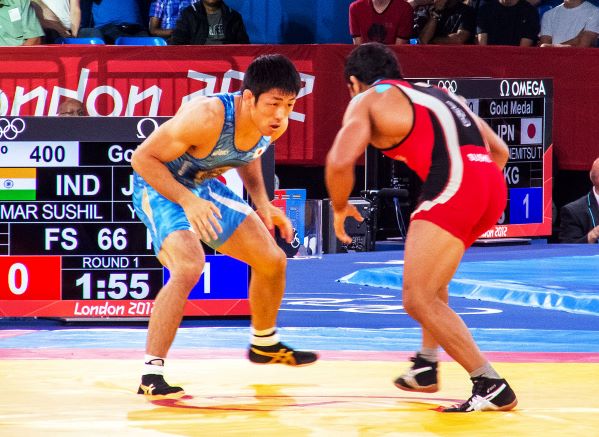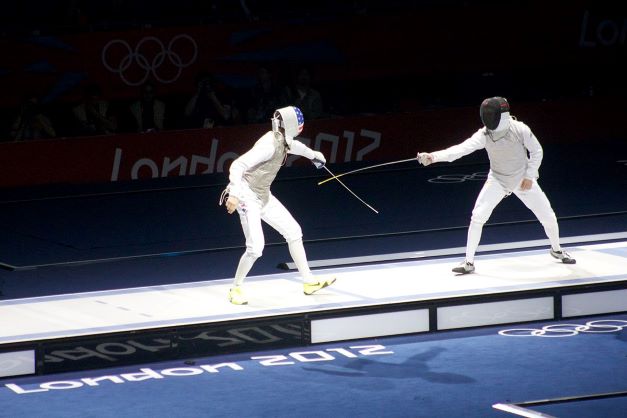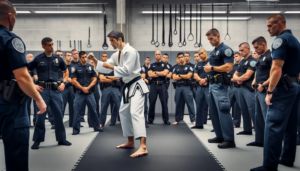
Are you wondering what martial arts are in the Olympics?
In this article, we’ll look at the Olympic martial arts and their short history, rules, and weight classes, as well as the most successful nations within each.
Contents
What Martial Arts Are in the Olympics?
The 2020 Tokyo Olympics featured 6 martial arts. They were boxing, fencing, judo, karate, taekwondo, and wrestling.
The 2024 Paris Olympics will feature only 5 martial arts. They are boxing, fencing, judo, taekwondo, and wrestling. Karate made its introduction at the 2020 Olympics but will not be included in the 2024 Paris Olympics.
Martial arts are only contested at the Summer Olympics (not winter) which take place every 4 years.
Here are the Olympic martial arts in order of when they first made an appearance at the games.
Wrestling (708 BCE)

Short Olympic Wrestling History
Wrestling was the first Olympic martial art, introduced in Ancient Greece at the 18th Olympiad, 708 BCE. Here, wrestling was hugely important because it was the last event of a pentathlon (five events) and therefore crowned the winner.
In 1896 at the first modern Olympic Games, Greco-Roman wrestling was introduced. In 1900 Greco-Roman wrestling was removed, and in 1904, freestyle wrestling was introduced before being removed in 1912.
Greco-Roman wrestling came back in 1908 and has featured at every Olympics since, while freestyle wrestling was reintroduced in 1920 and has featured at every Olympics since. Women’s wrestling was introduced at the 2004 Athens Olympics and has been featured ever since.
Olympic Wrestling Rules
Greco-Roman and freestyle wrestling have near identical rules, the difference is that in Greco-Roman wrestling a wrestler can’t attack below the waist or trip, lift, or execute any holds with the use of their own legs.
Meanwhile, in freestyle wrestling, all of the above is allowed.
In 2013, wrestling was close to being removed from the Olympic Games due to low ticket sales but this led to a change in wrestling rules for the Rio Olympics in 2016. The rules are as follows:
The aim in both styles is to pin an opponent’s shoulders (both shoulders) to the mat for 1 second; which automatically wins the match.
However, wrestlers can also win by technical superiority (point scoring). In Greco-Roman wrestling, an 8-point lead is required, while in freestyle wrestling it’s 10. If these numbers are reached, the match is automatically finished.
There are 2 three-minute rounds, with a 30-second break between. Point scoring is accumulative over both periods and if the match isn’t won within the 6 minutes, the wrestler with the highest points wins.
Points are scored many ways, but can be split into 5 main categories:
- Takedowns
- Turns
- Throws
- Counters
- Forcing an opponent out of the mat (1 point)
Men’s Olympic Wrestling Weight Classes
Greco-Roman (men only)
- 60 kg (132.3 lbs)
- 67 kg (147.7 lbs)
- 77 kg (169.8 lbs)
- 87 kg (191.8 lbs)
- 97 kg (213.8 lbs)
- 130 kg (286.6 lbs)
Freestyle
- 57 kg (125.67 lbs)
- 65 kg (143.3 lbs)
- 74 kg (163.1 lbs)
- 86 kg (189.6 lbs)
- 97 kg (213.8 lbs)
- 125 kg (275.6 lbs)
Women’s Olympic Wrestling Weight Classes
Freestyle
- 50 kg (110.2 lbs)
- 53 kg (116.8 lbs)
- 57 kg (125.7 lbs)
- 62 kg 136.7 lbs)
- 68 kg (149.9 lbs)
- 76 kg (167.6 lbs)
In terms of wrestling success at the Olympics, the USSR is ranked 1 with 62 gold medals and 116 total, the USA is ranked 2 with 55 golds and 138 total, and Japan is ranked 3 with 37 golds and 76 total.
Boxing (688 BCE)

Short Olympic Boxing History
Boxing was the second martial art in the Olympics, first introduced in Ancient Greece at the 23rd Olympiad, 688 BCE, in commemoration of Achilles’ fallen friend, Patroclus.
It was referred to as pygmachia, which translates to fist fighting. The fights had no rounds and lasted until an Olympian was unconscious or admitted defeat by holding up a finger.
Boxing was in the Olympics until the games were abolished in 393 AD by the Roman Emperor, Theodosius I. Boxing picked up in popularity during the 16th century, and during the 19th century, the Queensberry rules were introduced.
This brought padded gloves, three-minute rounds, and a 10-second knockdown count. Boxing was reintroduced as an Olympic martial art at the 1904 St Louis Olympics and in 2012 women’s boxing was introduced at the London Olympics.
Olympic Boxing Rules
Olympic boxing is considered an amateur format, as it features differing rules from professional boxing.
It features 3 three-minute rounds with a 1-minute rest between rounds and the contest is scored by 5 judges who award points for each successful hit. Punches to the back of the head and below the belt are illegal.
The three main ways to win are:
- Knocking an opponent unconscious or unable to continue
- Knocking an opponent to the ground who’s then unable to get back to their feet within a count of 10
- More total hits as scored by the judges
Men and women have different weight classes and they are:
Men’s Olympic Boxing Weight Classes
- Flyweight 48-52kg (105.8-114.6 lbs)
- Featherweight 52-57kg (114.6-125.6 lbs)
- Lightweight 57-63kg (125.6-138.9 lbs)
- Welterweight 63-69kg (138.9-152.1 pounds)
- Middleweight 69-75kg (152.1-165.3 pounds)
- Light Heavyweight 75-81kg (165.3-178.6 pounds)
- Heavyweight 81-91kg (178.6-200.6 pounds)
- Super Heavyweight 91kg+ (200.6 pounds+)
Women’s Olympic Boxing Weight Classes
- Flyweight 48-51kg (105.8-112.4 lbs)
- Featherweight 54-57kg (119-125.6 lbs)
- Lightweight 57-60kg (125.6-132.3 lbs)
- Welterweight 64-69kg (141.1-152.1 lbs)
- Middleweight 69-75kg (152.1-165.3 lbs)
Usually, the Olympic boxing qualification is run by the International Boxing Association, but following concerns over their refereeing and judging process, the process for the 2024 games will be overseen by the International Olympic Committee.
Before the 2024 Olympics, the USA was leading the way in Olympic boxing with 117 medals (50 gold), Cuba was second with 78 (41 gold), and Great Britain was third with 62 (20 gold).
Fencing (1896)

Short Olympic Fencing History
Fencing originates from swordplay of which there is evidence from 1190 BCE in Ancient Egypt. Fencing first featured at the 1612 Cotswold Olympick Games, which were a precursor to the modern Olympic Games restarted in 1896.
Fencing was then introduced at the 1896 Athens Olympics and has featured at every following Olympics. Women’s fencing first appeared in the 1924 Olympics in Paris and has been featured ever since. Fencing was the first and only martial art to feature at the first modern Olympics in 1896.
Olympic Fencing Rules
There are three types of fencing based on the three different weapons available, sabre, épée, and foil.
Foil is the lightest and most flexible fencing weapon, and fencers can only score with the tip of the foil to the torso or back of an opponent.
Epée is the largest, heaviest, and most sturdy fencing weapon, and fencers can score with the tip of the épée by touching any part of an opponent’s body.
Epée fencing is the only type where the ‘right of way’ rule is ignored, meaning both fencers can score a point at the same time.
Sabre is the fastest fencing weapon and fencers can score on any part of an opponent’s upper body above the waist (including the head and arms) with thrusts and slashes (tip, edge, and back of the blade).
Fencers dress in full body protection with masks, gloves, jackets, and underarm protection. The outfit is fully protective as it’s made with bulletproof material Kevlar.
Fencers also wear lamé jackets which are electrical clothing that keep the score by distinguishing between on and off hits.
There is individual and team fencing at the Olympics. In individual fencing, the winner is the first to 15 points, accumulated through 3 three-minute periods with one-minute breaks between.
If points are tied at the end of time, fencers enter sudden death where the winner is decided by the first point scored.
In team fencing, the winners are the first to 45 points or the team with the most points at the end of time.
Teams are composed of 3 fencers and they fence individually against each other. There are 9 rounds, and each fencer has 1 round before they’re rotated.
A team-mate inherits the previous round’s score and is fencing to the next cap of 5 points, which goes up by 5 each round.
Here are the fencing events to take place at the 2024 Paris Olympics at the Grand Palais:
- Individual epée (men/women)
- Individual foil (men/women)
- Individual sabre (men/women)
- Team epée (men/women)
- Team foil (men/women)
- Team sabre (men/women)
Italy is the most successful Olympic fencing nation with 130 total medals (49 gold), France is second with 123 (44 gold), and Hungary are third with 90 (38 gold).
Judo (1964)

Short Olympic Judo History
Judo was created in 1882 by Kano Jigoro Shihan (Japan) and first appeared at the 1964 Tokyo Olympics. Judo was removed in 1968 but returned for the 1972 Olympics and has been a mainstay at every summer Olympics since.
Women’s judo first appeared at the 1992 Barcelona Olympics and has been featured ever since.
Olympic Judo Rules
To win, a Judoka has to score an Ippon.
An Ippon can be scored by:
- Throwing an opponent onto their back with force
- Pinning an opponent on their back for 20 seconds
- Submission via arm lock or choke (strangulation)
An Ippon can also be achieved by scoring 2 Waza-ari.
A Waza-ari can be scored by:
- Less forceful throws that land an opponent on their back, sides, or shoulders
- Rolling an opponent onto their back
- Pinning an opponent on their back for 10-19 seconds
Originally, an opponent’s legs could be attacked for throws and locks, but in 2013 judokas were no longer allowed to touch an opponent’s legs during tachi-waza (standing techniques).
A bout is 4 minutes long and if points are equal at the end, judokas enter ‘golden score’. Here, play continues until a winner is decided by the first Ippon or Waza-ari scored.
There are a total of 68 throws (nage-waza) and 32 grappling techniques (katame-waza) that judokas can use. Judokas wear a jacket, trousers, and belt – the judogi.
The judoka that dominates the grip of an opponent’s jacket usually dominates the fight as they have control and can initiate throws.
Men’s Olympic Judo Weight Classes
- 60 kg (132.3 lbs)
- 66 kg (145 lbs)
- 73 kg (161 lbs)
- 81 kg (178.6 lbs)
- 90 kg (198.4 lbs)
- 100 kg (220.5 lbs)
- 100 kg+ (220.5 lbs+)
Women’s Olympic Judo Weight Classes
- 48 kg (105.8 lbs)
- 52 kg (114.6 lbs)
- 57 kg (125.7 lbs)
- 63 kg (138.9 lbs)
- 70 kg (154.3 lbs)
- 78 kg (172 lbs)
- 78 kg+ (172 lbs+)
Mixed Olympic Judo Teams
Since the 2020 Tokyo Olympics, the mixed judo team competition was introduced and will also feature at the 2024 Paris Olympics.
It features 6 athletes from each nation, three men (-73kg, -90kg and +90kg) and three women (-57kg, -70kg and +70kg). Bouts are individual and a nation needs a 4:2 win to qualify for the next round.
In Olympic Judo, Japan is the frontrunner with 96 medals (48 gold), France is second with 57 (16 golds), and South Korea are third with 46 (11 gold).
Taekwondo (1988)

Short Olympic Taekwondo History
Taekwondo originated in Korea (50 BCE) and was first demonstrated at the 1988 Seoul Olympics in South Korea.
12 years later, taekwondo became an Olympic martial art for both men and women at the 2000 Sydney Olympics and has featured in every summer Olympics since.
Taekwondo Olympic Rules
Taekwondo translates to ‘the way of kicking and punching’ and fighters can win by either knockout, outscoring their opponent by the end of time, reaching a 20-point gap, or being the first to 40 points.
To score a point, fighters have to hit their opponent with force; light hits will not score points. Points are scored by hitting an opponent’s head or Hogu (trunk protector).
Scoring is tracked electronically as part of the Protective Scoring System (PSS) first used at the 2012 London Olympics. The PSS introduced sensors in headgear, hogu, and socks, to measure the impact and validity of strikes.
Points are scored by:
- Punching the trunk protector – 1 point
- Kicking the trunk protector – 2 points
- Turning kick to the trunk protector – 4 points
- Kick to the head – 3 points
- Turning kick to the head – 5 points
- Every penalty (known as gam-jeom) given against the opponent – 1 point
There are 3 two-minute rounds with a one-minute break between rounds. If the scores are tied at the end of 3 rounds, there’s a Golden Point Round where the winner is the first person to score.
Contestants aren’t allowed to punch an opponent in the face and punches must only be thrown with a straight punching technique. Kicks only score points if they’re delivered by the foot below the ankle bone.
Men’s Olympic Taekwondo Weight Classes
- 58 kg (127.9 lbs)
- 68 kg (149.9 lbs)
- 80 kg (176.4 lbs)
- 80 kg+ (176.4 lbs+)
Women’s Olympic Taekwondo Weight Classes
- 49 kg (108 lbs)
- 57 kg (125.6 lbs)
- 67 kg (147.7 lbs)
- 67 kg+ (147.7 lbs+)
South Korea are the most successful with 22 medals (12 gold), China is second with 11 (7 gold), and the USA are third with 10 (3 gold).
Related Questions
Is MMA in the Olympics?
No, MMA isn’t in the Olympics and will not be at the 2024 Paris Olympics.
MMA has never been in the Olympics but there was a similar form known as pankration, introduced in the 33rd Olympiad 648 BC, not long after boxing and wrestling.
Pankration was a mix of boxing and wrestling where Olympians fought until one was badly hurt and couldn’t continue, or they surrendered by raising their index finger.
There were only two rules, no biting and no gouging. As well as boxing and wrestling, Olympians were also allowed to kick, lock, and choke their opponents; meaning early elements of jiu-jitsu were involved despite it not being a martial art yet.
Will Karate Be in the 2024 Paris Olympics?
Karate will not be in the 2024 Paris Olympics after its introduction in the 2020 Tokyo Olympics.
Karate was removed because younger audiences have no interest in it compared to other more popular sports. There are also new rules in place to limit the size of athletes at the Paris Olympics, so karate was cut as it was the newest addition.
Conclusion
The 5 Olympic martial arts are wrestling, boxing, fencing, judo, and taekwondo. There were 6 Olympic martial arts at the Tokyo 2020 Olympics, but karate has been removed from the 2024 Paris Olympics.
Wrestling and boxing have the most Olympic history, both featuring since the Olympic Games were first invented in Ancient Greece, starting with wrestling in 708 BCE and boxing in 688 BCE.
Fencing is the only weapon-based martial art in the Olympics, featuring in the first modern Olympics in 1896, while judo and taekwondo are new martial arts that have been featured since 1964 (judo) and 1988 (taekwondo).




